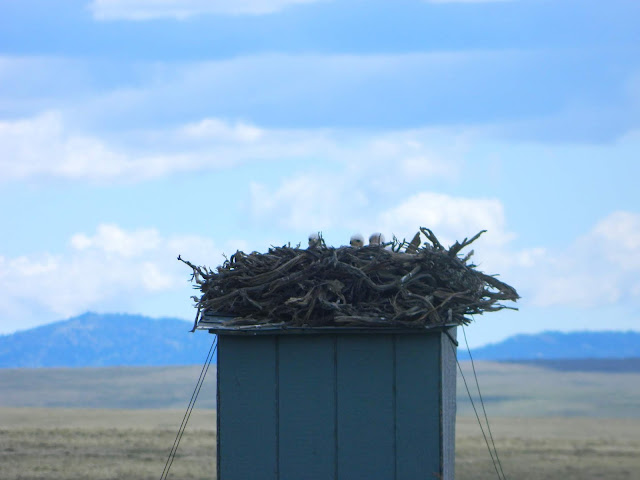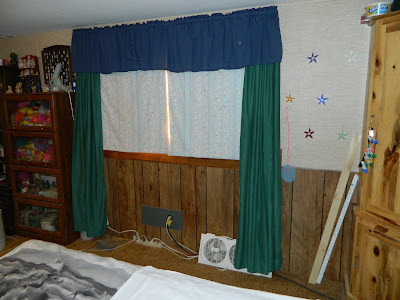These are the black-out insulating curtains I made. I didn't want to go back with the warm window curtains I had due to cost and complexity of construction. So I had to come up with a new method. See below the pictures for instructions.
Bedroom window with swamp cooler and air conditioner
Large bedroom window
This curtain opens by moving one panel to the other side, double-hanging both curtains on one side on the l-hooks that hold the curtains up (see below for more details). If I want to have the entire window uncovered, I toss the curtains on the bed for the day.
This is what the curtain looks like open half-way. This is the usual situation with this curtain. It can hang off to either side of the window.
Living room window
These are used only in the summer when it's extremely hot. Since they are hung on l-hooks, they easy go up and down. I made a box in which to hang them when they are not on the windows. In the winter, the box gets covered and the curtains store in the shed.
Spare bedroom
Bathroom 1
This is not like the other curtains, It is just an insulation panel cut to fit inside the window against the glass and covered with a fabric envelope. I used snaps to hold the panel inside after closing the top of the envelope and there's a tab to pull it back out of the window when I want it out.
Bathroom 2
This is the same as the larger curtains, only using denim for the covering.
I started with bubble type insulation I bought in a roll from Home Depot. It's 15 inches wide and I had to sew two panels together for my 29 inch wide windows. I just hand-sewed it, securing the top and bottom when I started so it wouldn't shift. I bought the type of insulation with a staple tab, which just meant the inch on each side had flattened bubbles. I overlapped by an inch for the middle seam, taking advantage of the staple tab to get a flat seam.
You will need to measure your windows and decide how wide and long the curtains need to be. That's up to you. Also, the rods will have to be cut to size, with and extra 1/2" or so to keep the curtain on the hooks it hangs on. Most of this will become obvious as you progress.
I used fabrics I had on hand. Once you determine your window size, you can calculate the amount of fabric you need. If you have fabric available, you can make a paper pattern for the size of curtain required and then lay it on the fabric to check and see if you have enough fabric. Otherwise, you'll have to do some math! Any lightweight fabric will do. I used denim on my small bathroom window, but that would be too heavy for these curtains.
I will note that plaid may not be a good choice of pattern. I had a hard time getting all the seams and casings perfectly straight and it is very noticeable on plaid!
The covers are an envelope into which the insulation slides. I sewed ribbons into the casing and the side with just the turned over edge so I could secure the envelope together at the top, rather than using a permanent seam that wouldn't allow for easy washing and fabric replacement. This was probably the slowest part—the ribbons were stubborn about staying pinned in place!
This is the envelope with the insulation pushed inside. The middle seam goes down the middle of the envelope vertically. I trimmed any pieces that did not quite fit. You want a tight fit for a smooth looking curtain, but not bulging or curving. It needs to lay flat. The white rods off to the right are what I used to hang the curtains with. They are 3/16" rod I got from a local recycling business. I painted them white to give them a nicer look than bar metal. If your curtains are long, you may need a slightly larger diameter rod. However, these are very lightweight curtains.

This is the envelope, tied together, with the rod run threw the casing and the silver insulation inside. The ties keep the envelope "sealed" and allow easy removal of the fabric should you need to wash or replace it. This makes the curtains very easy to repair or change the colors of the fabric should you want to do so. That was a problem with the warm window curtains—hard to replace the fabric cover that showed on the inside of the room. Mine was never replaced. The fabric also had to be vacuumed rather than being washable like these are.
I did sew small buttons on the corners to hold the insulation in place (see picture below). I put 3 buttons on the top curtains because I made them longer to overlap the bottom ones, but they are difficult to visually identify as longer. The extra button makes this easy. (I will have to cut the buttons off should I replace the cover or the insulation, but that's not a big problem.)


I installed the curtains using l-hooks I purchased at the local hardware store. The curtains for the taller windows are in two pieces, allowing one to open all or half the window. The bedroom ones with the air conditioner and swamp cooler have extra hooks that allow the curtain to be hung either above the air conditioner and swamp cooler, or to cover to the bottom of the window in the winter. If we only want to open the curtain half way, the bottom curtain moves to hang with the top one on the top hooks. If the full window is opened, I toss the curtains on the bed during the day. I used longer hooks on top to accommodate the double hanging of curtains.
Because the curtains can slide off the rods, I put rubber bands on the rods to prevent this. It's optional. If the casing is tight enough or you don't move the curtains often, they will not be needed.
See the button sewn on to hold the insulation in place? There's one on each corner and an extra one in the middle on the top curtain.
An additional notes:
These are not as effective as the warm window curtains because they simply hang on a rod and have no magnetic strip holding them tight against the wall. However, I have had them freeze to the window on cold nights, so they do insulate. They also block virtually all light. These are much lighter and easier to deal with than hanging a blanket over the window or other varients on DIY warm window curtains. As noted, I do have them freeze to the window due to condensation on the window. My house has a condensation problem and it stained the warm window curtains on the window side quite badly. This is why I chose to make covers that can easily be replaced.
That's it. Should you have any questions, feel free to ask in the comment section.

















































